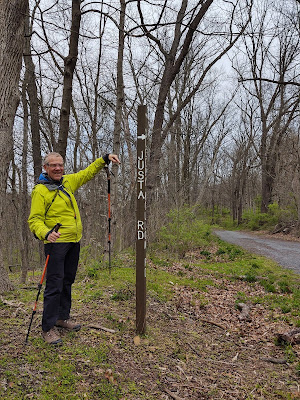April 28, 2020
Hi Blog!
The past two days have been a washout. The weather this April has been cold and wet. When we woke up this morning to blue skies, we knew we had to get out for a hike. With two straight days of rain, we decided to head back up to the Appalachian Trail. The trail tends to be rocky so it doesn't stay wet for long. Today's adventure took us to Port Clinton. In order to practice social distancing, we picked a small parking area and headed north on a difficult section of trail.
It is well know to Thru-Hikers that Pennsylvania is where hiking boots go to die. At our trailhead, someone discarded a pair of broken hiking boots.
A blue blazed side trail took us from the parking area off Route 61 down to the banks of the Schuylkill River. The AT follows the banks of the river as the river cuts its way through the Blue Mountains.
After following an old railroad grade and wondering whether or not it was the trail, we finally found the ubiquitous white blaze - and now our hike begins!
It is believed that Schuylkill is a Dutch name. Kil means "creek" and schuylen means "to hide, skulk" or "to take refuge, shelter." One explanation given for this name is that it translates to "hidden river", "skulking river" or "sheltered creek" and refers to the river's confluence with the Delaware River at League Island, which was nearly hidden by dense vegetation. Since the trees have just begun to leaf out, the river wasn't hidden to us.
We thought this little collection of trash was either some kind of trail maintenance or some urban art installation. We had no idea what was to come.
The trail crossed under Highway 61 as the highway headed out over a bridge above the Schuylkill River. We first noticed the tree decorated with socks in the photo below. We just figured some Thru-Hiker washed some socks in the river and hung them to dry. We soon realized is wasn't a hiker, but a homeless person taking refuge under the bridge. When we crossed under, no one was home at the time, but the place looked well lived in.
What we first thought was poetry or journal entries from Thru-Hikers turned out to be long rants about everything from politics to religion. Some of the rants were signed Wolfman of Helltown. It wasn't until we returned home and Googled, that we discovered that the Wolfman is an AT oddity. There are numerous blog posts from hikers who ran into this guy at shelters in the area, where he rants for hours at a time and leaves manifestos all along the trail. We saw him briefly on our return trip, but once he saw us, he hid in the bushes (probably out of fear of Covid-19, although we had our masks on), so we never got the pleasure of listening to his rants in person.
Just past the bridge, we began our climb up to the top of the ridge.
The trail was well marked.
After about a half mile of switchbacks, we found ourselves looking down on Port Clinton. Port Clinton was once a thriving place. The leading business had been the shipment of coal from the mines in the vicinity. Today, most folks work for the railroad and distribution centers.
Once we recovered from all that uphill climb, we were able to enjoy the view.
We followed the ridge as it headed northeast. This part of the trail is a knife edge. We had views both north and south. When we noticed a couple hikers coming our way, we stepped off trail to let them pass. It gave us a chance to admire some the spring flowers.
For part of our hike, we were joined by a mourning butterfly.
After about three miles, we found a comfy place to sit and relax and enjoy our peanut butter and jelly sandwiches on Amish peach bread. Living in Lancaster County has perks.
As we hiked back along the knife edge, Dave recorded this 360-degree video from the ridge. At the same time, Kathy recorded Dave recording the 360-video!
The next time we come to Port Clinton, we'll follow the AT south. In the meantime, we'll be house hunting, cleaning and dodging rain drops. Stay safe and keep smiling!



































































